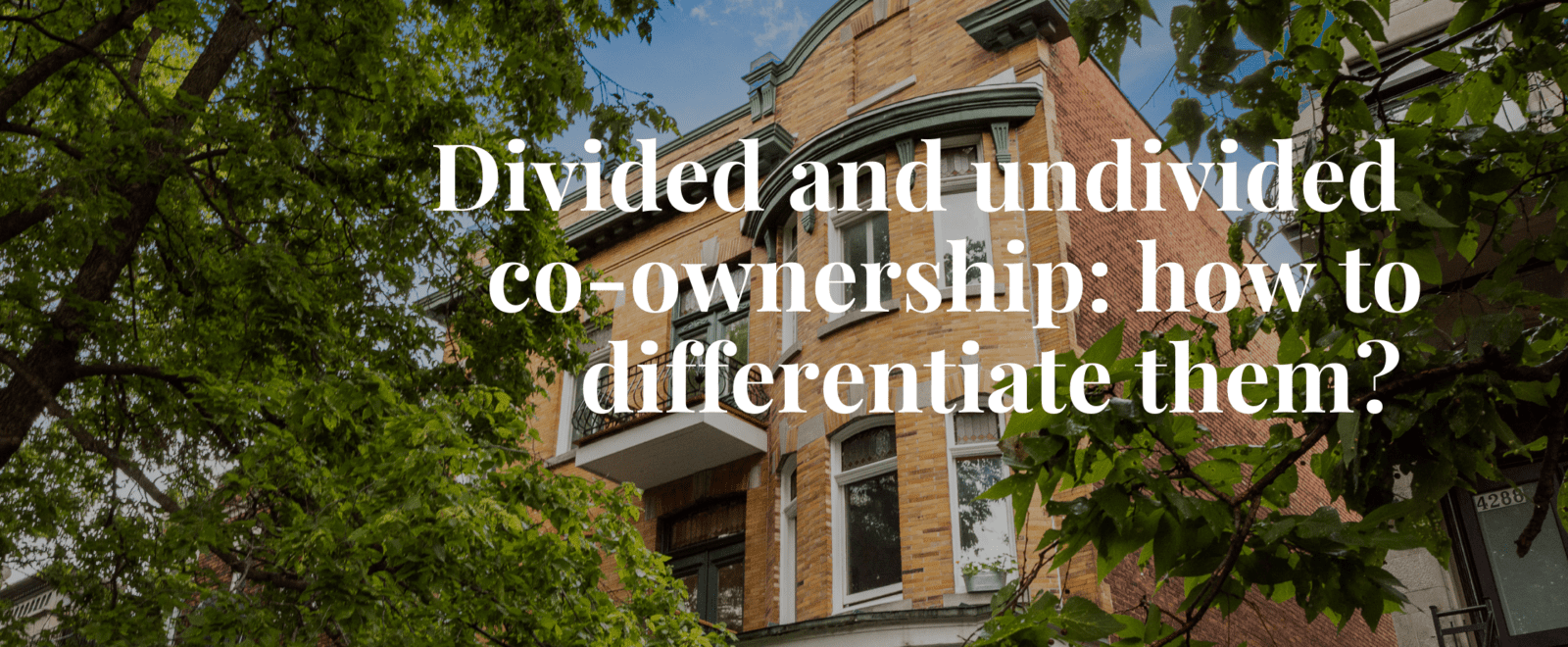Buying a property is an important step in anyone’s life. There are different types of properties on the market, including single-family homes, plexes (duplexes, triplexes), cottages or second homes and condominiums. Condominiums are increasingly popular, particularly in the city of Montreal. However, it is important to know the different nuances of co-ownership in order to make a wise choice during the process of finding or buying your property in Montreal.
What is a co-ownership?
A co-ownership is the sharing of a common good by several owners, hence the use of the prefix “co”. This therefore means that there is a common sharing of places (balconies, stairs, courtyards) between the co-owners and a private space (the apartment). There are two types of co-ownership in Montreal: divided co-ownership and undivided co-ownership.
But what are the particularities of these two types of co-ownership?
Divided co-ownership
This type of condominium, also called a ”condominium” is the most popular in Montreal and continues to grow in popularity. According to the Société d’Habitation du Québec, this form of co-ownership is still recent, not having appeared until 1969. It created a certain buzz towards condominiums in Quebec.
In a divided co-ownership, each household owns its own apartment and shares other parts of the building such as the elevator, the swimming pool, the gym, the land, the corridors etc. balcony or terrace. When buying a divided property, the buyer must put down a 5% down payment.
Net area
In the property description sheets, it is the net area that is used. This designates the actual measurement of the private portion.
In addition, the owner of a divided co-ownership will have his own municipal and school tax bill. The same is true for the mortgage. If the owner wants to sell, then he can do so freely, without the advice of the co-owners.
Co-owned syndicate
The divided co-ownership is also supervised by a syndicate of co-ownership which will ensure the respect and the good administration of the building.
Undivided co-ownership
Undivided co-ownership is very different from divided co-ownership. In fact, in an undivided co-ownership, the owners each have a percentage of the building. There are therefore several owners of the same building.
When buying an undivided co-ownership, an important difference with a divided co-ownership is that the owners must give a 20% down payment on the property and be financed by a common bank. This can then narrow the pool of potential buyers.
Gross area
In the property description sheets, it is the gross area that is used. It is calculated by the architectural plans (private part) and includes certain so-called common parts (eg: peripheral walls, support columns, etc.).
In the case of an undivided co-ownership, municipal taxes, school taxes and the mortgage are divided between the owners. Unlike divided co-ownership, the rental of an undivided unit is not accepted. If the owner wants to sell, he will need the approval of the other co-owners.
Joint ownership agreement
Unlike divided co-ownership, there is no syndicate that ensures the proper administration of the building, but an indivision agreement detailing the rights of each and giving details on the management of the building. the undivided co-ownership. The various charges for the maintenance of the building must also be separated between the owners depending on the shares of each. The joint ownership agreement is not mandatory, but is strongly recommended.
Important information
Undivided co-ownership does not allow its co-owners to rent. Indeed, this is a form of protection in favor of the main tenant. In addition, during a real estate transaction with an undivided co-ownership, the right of first refusal must be considered. This right allows, among other things, the co-owners of the undivided co-ownership to buy back the undivided share of the building. The owner can then sell his property to the other co-owners of the building. The price and the various conditions of sale are then presented. The co-owners then have a certain period to make their decision, and if necessary, waive their right of pre-emption and allow a new owner to be part of the joint ownership. However, a buyer of an undivided co-ownership must have received the approval of all the undivided co-owners of the building.
As seen above, divided and undivided co-ownership have major implications and differentiations. When looking for a property, being aware of these implications and knowing the type of condominium you want to buy will help avoid unpleasant surprises and make a more informed choice.
Contact one of our real estate brokers for additional information on divided and undivided co-ownership
Consult other real estate news

Réformes hypothécaires : vers un accès facilité à la propriété pour les Canadiens
Dès le 15 décembre prochain, il sera plus accessible pour la population canadienne d’acquérir une propriété grâce à deux nouvelles réformes mises en œuvre par

Leasing your property with a real estate broker
Leasing your proprety with a real estate broker – Key Information Residential renting is a common practice in Montreal, both among tenants and landlords. In

Real estate overbidding: how much should a buyer offer for a property?
How much a buyer should offer to purchase a proprety – Key Information Real estate overbidding: how much should a buyer offer for a property?







